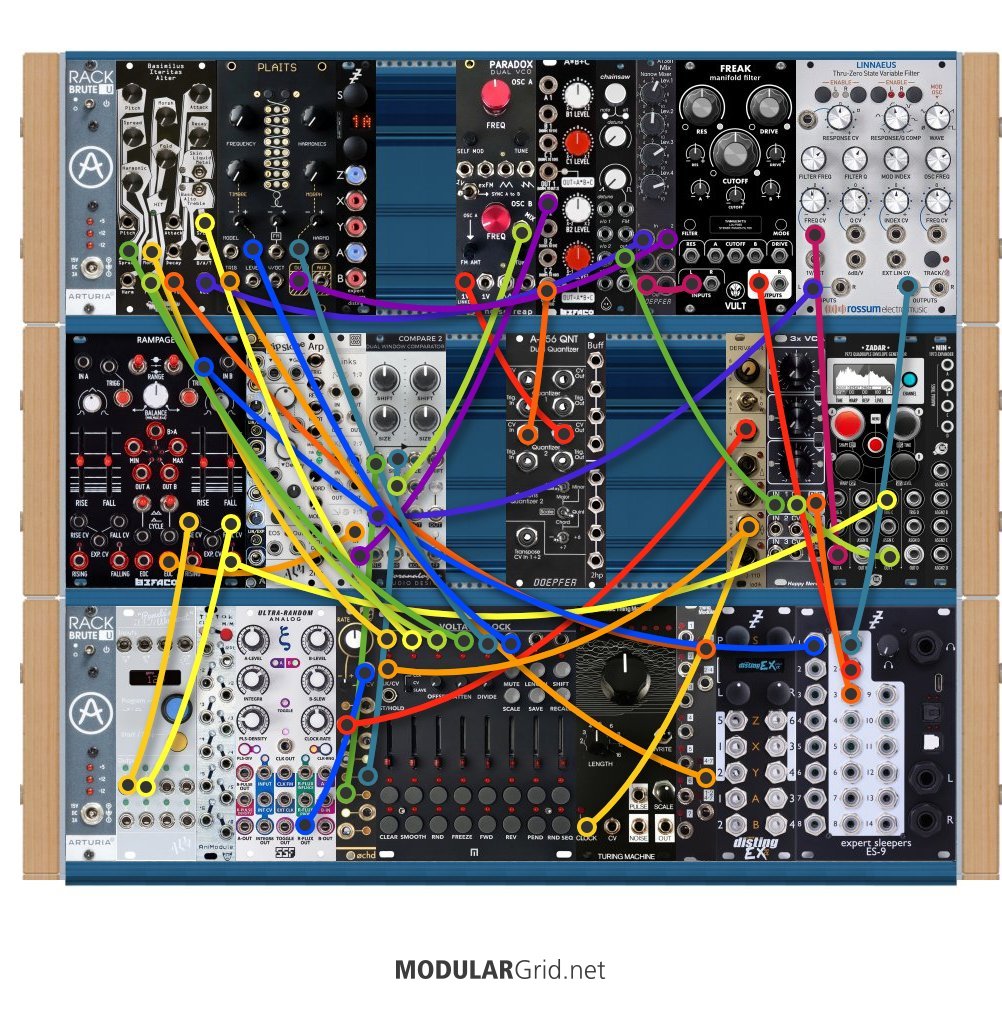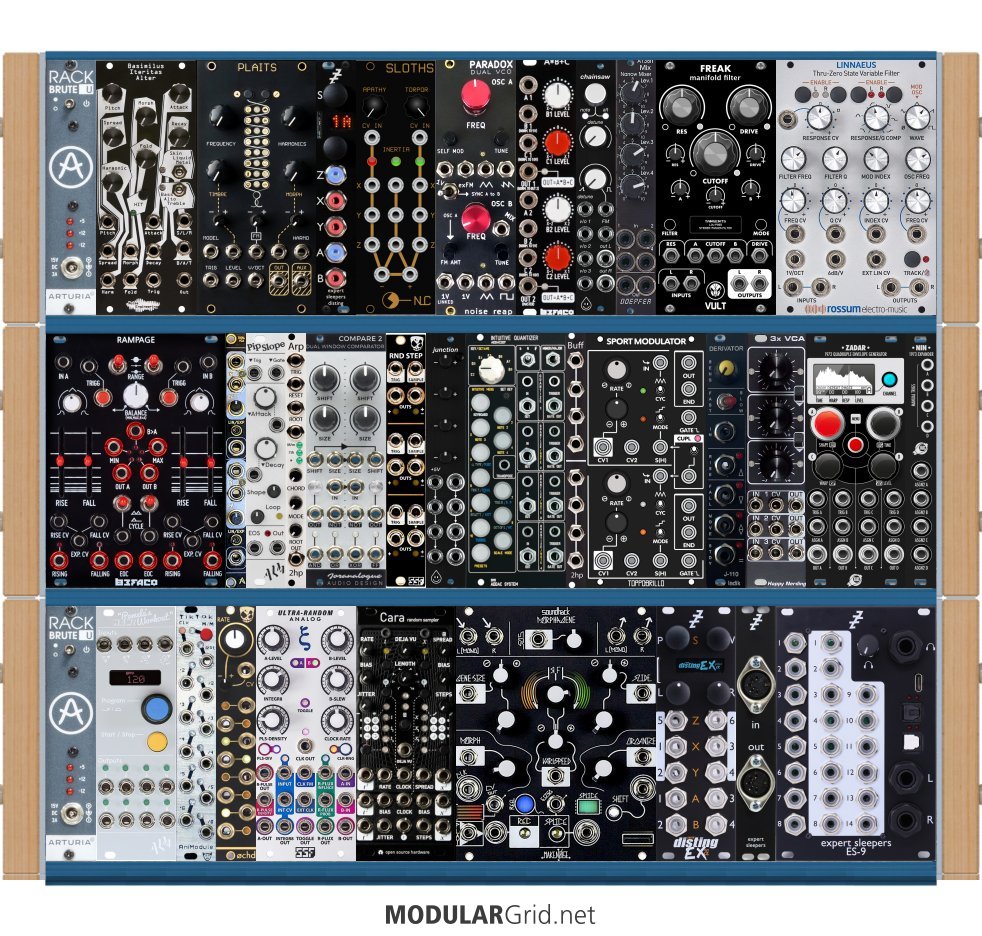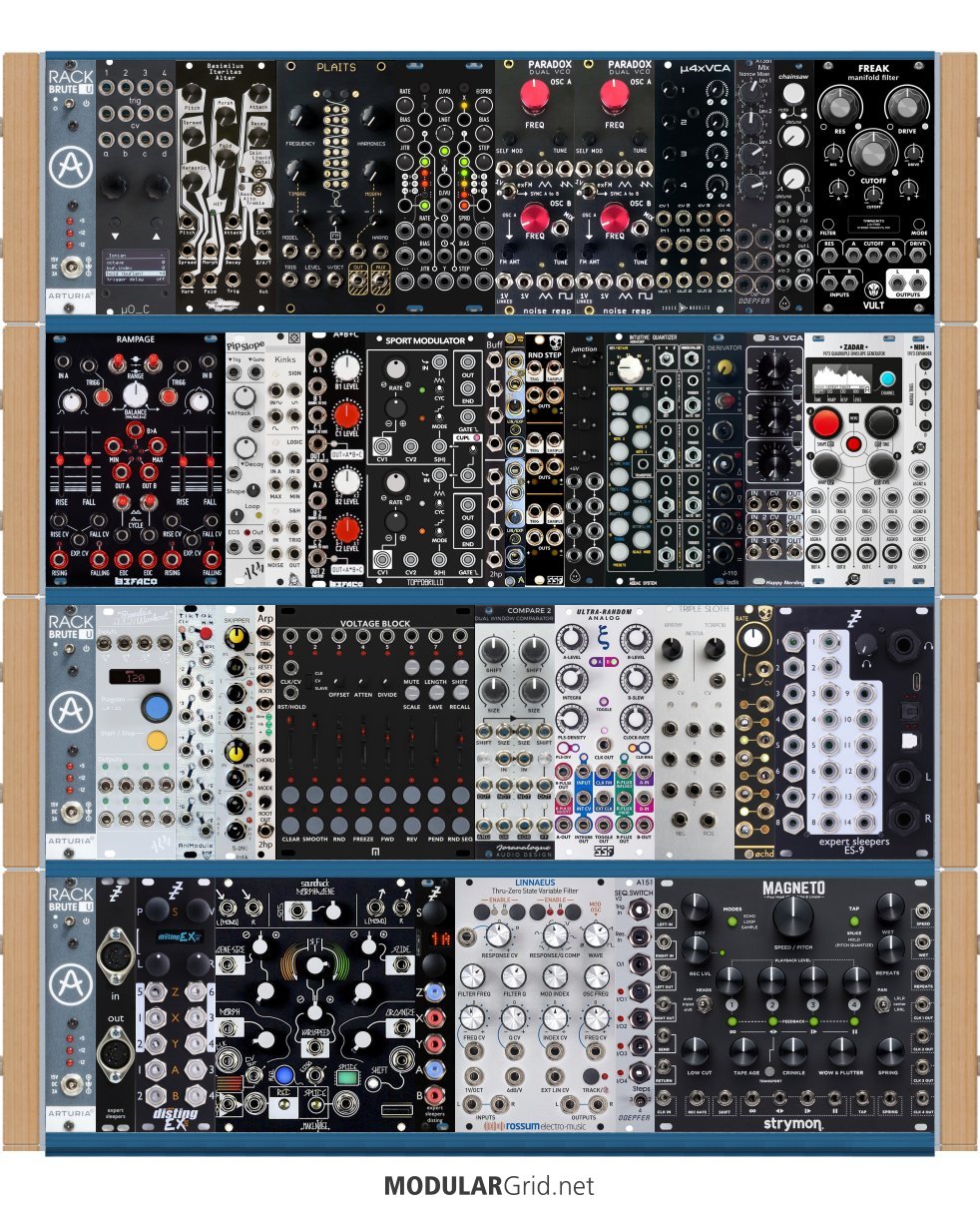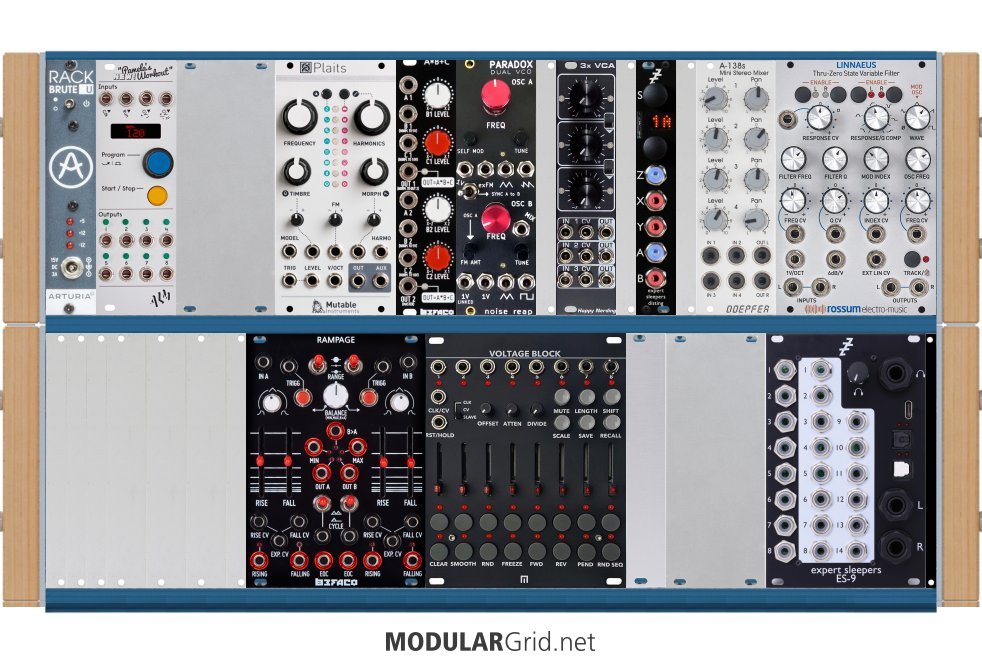
This is the rack side of a generative/krell patch I did for a recent contest held over on Colin Bender's Discord, and managed to win 2nd place. I wrote some patch notes for it which I'll paste below. It's a hybrid patch, with the core looping cycle done from there. The track was recorded direct from VCV, I don't use a DAW (believe me, I've tried haha) and I know nothing about mastering etc so forgive the sound...
Can't figure out how to get an image of the VCV side of the patch into this post, maybe this will work: https://photos.app.goo.gl/9LBiCZ5u9KydeAxQA
You can find the VCV side of the patch here, if you’d like to play with it yourself. Don’t forget to trigger the Rampages in order of 1,2,3 to get it going: https://patchstorage.com/the-kolin-krell/
Here's the track:
And here's the nerdy notes:
I’ll cover the core of the Krell first, then try to explain the patch according to how the sounds come in when listening to the recording.
Core AD Loop
VCV: Rampage #1 has smooth random voltage fed into its Rise CV on Channel 1. Rampage #2 has different smooth random voltage fed into its Fall CV in Channel 2. Both of these Rampages feed their output into the Rise and Fall CV of Rampage #3 respectively. First two Rampages are set to long Rise/Fall times. Third Rampage has a shorter Rise/Fall time setting – this forms the core looping A/D engine for the patch. The varying cycles will more or less stretch apart, sometimes coming together in a fast sequence of cycles – you can use these moments to build crescendos.
Pitch & Chords
Pitch comes from a S&H triggered by the EOC, which is then quantized to C Minus, then sent to the ChordCV chord generator module from Aaron Static. The chord notes/pitches are then distributed to all of the voices in the VCV patch. Some oscillators like the Vult ones can accept polyphonic, so they get the full chord other oscillators get one of the four single notes
Clock Division and Distribution
VCV: The End of Cycle output on Rampage #3 sets the clock. This signal is used to time the arpeggiators. This signal is also duplicated then fed into a division of 2, before being fed to a clock divider, with divisions into 16, 32, 64 etc sent into a Teleport module for distribution around the VCV patch. The original EOC pulse and rise/fall is sent to another Teleport and then into the Audio 16 where it gets sent to the physical rack to trigger things there.
Drone 2 (DN-1)
Rack: The track begins with a sound from Drone 2 - a Noise Reap Paradox oscillator being fed pitch from a rack-side S&H, triggered by a rack-side Rampage, which is being triggered from VCV by the Core AD’s EOC clock. The rack-side Rampage’s rise and fall is being modulated by two smooth random voltages from Pam’s New Workout. The audio goes from the Paradox through a Joranalogue Compare 2 for loads of freq mangling, modulated by several free running LFOs from an Ochd, which in turn is modulated by smooth random from the SSF Ultra Random Analog module. That audio is then fed into a Rossum Linnaeus thru-zero variable state filter, with its frequency CV modulated by a warping envelope/LFO from a Zadar. The envelope share has a sharp rise in the middle, which creates a sharp, sudden ‘crack’ in the cutoff filter, these moments are there to add some tension throughout the track.
P1 & P2
Rack: The second sound that appears in the track are two percussion type noises coming from a Noise Engineering BIA and a MI Plaits. The fast triggers are extracted from the aforementioned Ochd using a Ladik Deviator (slope detector). The triggers are crazy fast sometimes so they’re being spaced apart by feeding the trigger into a Turing machine with a Pulses expansion, then taking pulses 1/2 to the BIA and pulses 4/7 to the Plaits. Same signal from the Ladik clocks a Voltage Block that is then used to modulate various parameters in the BIA and Plaits. These percussion sounds then get sent to VCV for reverb via Valley’s Plateau, and each one gets a different flange effect from the Vahalla Supermassive plugin.
Lead Voice
VCV: After a short while, a higher pitched voice fades in. This is a drone that I call the lead because it has no envelope and is not triggered by any clock division. It comes direct from the Krell looping A/D on Rampage #3 (to get the patch moving, you have to trigger the three Rampages manually, so Drone 1 starts to fade in once its AD gets triggered this way).
The Lead Voice is made up of several oscillators, some of which get their own reverb/fx, one with a randomized vibrato and other modulations, some get the full chord, some single notes, to get some kinds of progression moving around. One oscillator, the Basal from Vult, gets the full chord. They all go through a sub-mixer into a single filter & a VCA that’s fed the Rise & Fall from the core loop.
Drone 1 (DN-1)
VCV: This voice is triggered on every 8th division from the Krell EOC but runs through the Branches probability module. You’ll hear this come in at a higher pitch around 1:49 into the track. The drone runs through another Rampage with a very slow fall time, which works with a slow flange and z-massive size reverb from Vahalla to create super long tails, so multiple notes will play while the VCA is open, sounding a bit to me, like an electric guitar.
ARPs 1 & 2
VCV: At around 2:48, the Krell cycles finally start to crash into each other, which starts to trigger the Arpeggios. These get their signals direct from Rampage #3’s EOC, then placed through two signal delays to get them to feel like they’re trickling off the core rise and falls. First Arp is pitched high via a Chirp, with a snappy envelope and low pass gate - same for the other Arp but with a lower pitch, slower envelope and added echo. I wanted the Arps to occupy some of the highs and add interest to help prevent the patch from stagnating.
Drone 3 (DN-3)
Rack: This is the Acid Rain Chainsaw oscillator, freq modulated a little by the Ochd, running through a long envelope from Zadar, triggered by the start of the Fall segment on the rack-side Rampage. It just plays a fixed note.
Cel-1
VCV: Around 4:40 the first Supercell granular voice/effect comes in. It’s triggered at 32 or 64, which was divided by 2 before, so more like 64 or 128 EOCs (If I’m getting that right). It first gets the chord into the Bleak oscillator, which is set to polyphonic, then the signal is turned monophonic via the Orbit module so it can go into the Supercell granulator, which then has a nice loud volume in the mix and lingers for a long time, so acts like a crescendo moment.
Cel-2
VCV: Similar set up to the Cel-1 but pitched lower, and triggers at the same time, so it comes in under the Cel-1 for more oomph.
Cel-3
VCV: This is the big one! Or at least makes Cel-2 the big one, by taking a copy of the chord then passing it through a high pass filter with its own Chronoblob big echo. The envelope that opens this up is made slower than the Cel-2 and the whole thing is triggered x2 longer than Cel 1&2 so you’ll only hear it once or twice in a 15-20 min timeframe, I think.
Arranging
Most of the arranging is programmed with clock divisions to spread out the Krell cycles. The moments when the cycles come together tightly really speeds up the divisions and helps bring in the crescendo moment and activates the Arp trickle sounds. The only things I did in the recording was manually trigger the three Rampages to get it going, then at around 14 minutes, then after the final crescendo, when it started to calm down a bit, turn off the cycle switches on the Rampages and wait for the patch to slow to a halt in its own time before fading down.
Plugins
There are loads of VCV Host modules all over the patch, using various algorithms from the Vahalla Supermassive plugin - which is free. The entire mix is also put through the Rysy filter from Felt.






